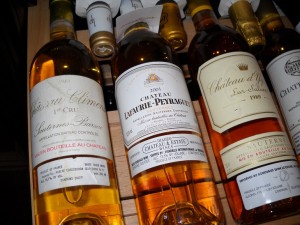‘Tis the season to be jolly and what better way to celebrate the season than with the gift of wine. Accordingly, our annual gift-giving guide returns this month to help you find the perfect gift for everyone on your list.
Beyond the bottle, a gift certificate from Grand Cru Classes is the gift that always fits. Purchase seats to a public class, provide them with wine consulting services or offer them the gift of a private wine event. Certificates are elegantly packaged with a set of wine charms and can be sent directly to you or the recipient (your choice).
For a very unique opportunity, why not treat someone in your life to a special winemaking series with Grand Cru Classes and Jim Waters, owner and winemaker at Waters Crest Winery? Details will be sent out separately as soon as they are available.
If you find yourself entertaining for the holidays and want to throw a wine-themed party, we still have a few dates available. Call or e-mail us for a quote.
Hosting on a smaller scale? Let us make your life easier with our wine shopping services. Simply provide us with your wine budget, number of guests expected and any themes or preferences and we’ll create the perfect wine list for your event, arrange for delivery and design customized tasting sheets and information on each wine, all for a flat fee of $175.00.
Drink wisely and well,
Tracy Ellen Kamens, Ed.D., DWS, CWE
CEO: Chief Education Officer
and
Jared Michael Skolnick
COO: Cork Opening Officer
CELLAR STOCKERS IV
The holidays bring a flurry of parties and visits with friends and family. Don’t arrive empty-handed. Instead, reach for a festive sparkler that sets the tone and is sure to please: Juve y Camps, Reserva de la Familia 2004, Catalonia, Spain, $13.00.
Hosting at home? Appeal to their green side with an organic wine (from Washington State’s first Certified Organic vineyard) that not only tastes great, but is also great for the environment with Badger Mountain Vineyards Pure White 2007, Columbia Valley, WA ($22.00 -3L box).
Show your parents you appreciate them with a wine from the year you were born. Check out a vintage chart to see what wines were ageworthy and are still drinking well; then, turn to a store that carries older vintages to find that special bottle. If this proves to be too much of a challenge, consider an elegant Italian wine: Scavino, Barolo Carobric 2004, Piedmont, Italy, $75.00.
You might be less enamored with your in-laws (or maybe not), but don’t let it show, by sending them world-class Chablis from a stellar vintage: Joseph Drouhin Domaine de Vaudon, Vaudesir Grand Cru 2008, Chablis, France, $72.00.
If you’ve made a new acquaintance, take this time to let them know you care with a fresh, fruit-forward white wine that isn’t among the usual suspects: Treana, Proprietary White 2007, Paso Robles, CA, $17.00.
Thank your best friend for being there for you all year long. Toast your friendship with a voluptuous Pinot Noir: Brooks, “Janus” Pinot Noir 2006, Willamette Valley, OR, $35.00.
Finally, let your love for one another shine through with the sparkle of Champagne in a romantic hue by choosing a classic rosé option: Ayala Rosé “Majeur” NV, Champagne, France $60.00.
See the Tasting Notes section for detailed notes on the above wines.
Tasting Notes
Juve y Camps, Reserva de la Familia 2004, Catalonia, Spain, $13.00
This family-owned winery is located in the heartland of the Penedes region – San Sadurni d’Anoia. Produced from a traditional blend of Macabeo, Parellada and Xarel-lo, the intense nose presents with notes of yeast, citrus and mineral, with rich flavors of citrus and yeast on the round and creamy palate.
Badger Mountain Vineyards Pure White 2007, Columbia Valley, WA, $22.00 -3L box
A blend of Semillon, Muller-Thurgau and Sauvignon Blanc, this wine has a wonderfully floral nose, but is dry on the palate with citrus and tropical fruit notes. With no sulfites or other preservatives added, the winemaking is organic as well. Packaged in environmentally friendly cardboard, this box contains the equivalent of 4 bottles of wine with a vastly reduced carbon footprint due to its lower weight, yet, once opened, will remain fresh for weeks.
Scavino, Barolo Carobric 2004, Piedmont, Italy, $75.00
A beautiful Barolo from highly respected winemaker Enrico Scavino, this wine has a very floral nose. The palate consists of black fruits – mostly dark berries – with continued floral notes, dried herbs and firm tannins, culminating in long length.
Joseph Drouhin Domaine de Vaudon, Vaudesir Grand Cru 2008, Chablis, France, $72.00
This wine has pronounced minerality, damp earth, bruised apple and a slight woody note on the nose, all of which re-appeared on the rich palate and remained throughout the exceedingly long finish.
Treana, Proprietary White 2007, Paso Robles, CA, $17.00
A 50-50 blend of Marsanne and Viognier (both Rhone Valley varietals), this wine is dry with very ripe, tropical fruit aromas. On the palate, pineapple and an undercurrent of stone persist throughout the medium length.
Brooks, “Janus” Pinot Noir 2006, Willamette Valley, OR, $35.00
A relatively complex wine for the price with vibrant acidity and very lush fruit, this palate shows raspberry, cherry, violet and slight herbal notes.
Ayala Rosé “Majeur” NV, Champagne, France $60.00.
Although Champagne house Ayala was established in 1860, its wines only recently returned to the U.S. With an elegant bouquet of fresh red fruits, the wine is dry with crisp acidity and raspberry and toast and is suitable as an aperitif, but can just as easily carry you through the meal and could even accompany light, fruit-based desserts.

